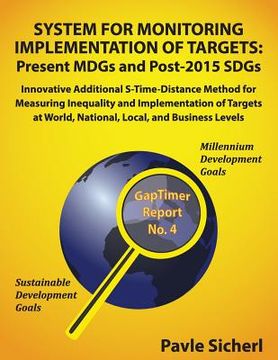System for Monitoring Implementation of Targets: Present MDGs and Post-2015 SDGs: Innovative Additional S-Time-Distance Method for Measuring Inequalit (en Inglés)
Reseña del libro "System for Monitoring Implementation of Targets: Present MDGs and Post-2015 SDGs: Innovative Additional S-Time-Distance Method for Measuring Inequalit (en Inglés)"
World inequalities are studied comparing time series data simultaneously in two dimensions: vertically static gap at a given point in time and horizontally gap in time for a given level of the indicator (Sicherl time distance) providing a broader picture. Empirically, when comparing across indicators and periods of time, static and time distance measures of disparity can give different preceptions of inequality. Firstly, with this innovative approach S-time-distance measure, expressed in time units, is easy to understand by everybody and offers a novel way to compare situations in economics, politics, business, and statistics. The time distance concept can influence the perception and decisions of people when they are assessing their relative position in their surroundings, in the society and across countries over time. 'The usual metrics for comparing two lines involves differences along the vertical axis. This can be a poor way of measuring how these trends vary in terms of time, which is on the horizontal axis.' ... 'Sicherl's several works have presented a non-technical discussion of the theory of time distance.' ... 'Observed time distance is a dynamic measure of temporal disparity between the two series, intuitively clear, readily measurable, and in transparent units which are comparable across a pairing of indicators and indicated variables. It is suggested that one should complement conventional vertical measures with horizontal measures.' (Granger and Jeon 1997) C.W.J. Granger and Y. Jeon, University of California at San Diego Secondly, the new generic time distance approach, which is easy to understand and to communicate, offers a new view of reality that significantly complements existing mostly static measures of inequality in many fields. The time distance methodology describes S-time-matrix format to view time series data across many units and over time, and two statistical measures, expressed in units of time (years): S-time-distance and S-time-step. The main part of empirical results deals with the monitoring implementation of the 10 selected MDG indicators over world regions and in details for five MDG indicators for 125-154 countries. For benchmarking the starting situation for the post-2015 discussions the world level comparisons for about 200 countries it is calculated: how many years their recent values are behind or ahead in time against the long-term trend of Sweden as benchmark for 4 major development indicators. It is very important how people understand data and indicators. We need new data and indicators but we also need innovative concepts of looking at data and new generic statistical measures to better perceive and exploit the information available in existing data. Time is of essence in all domains, it is important both as operational and comparative metric. These additional insights have also a transparent matter-of-fact message to politicians and the international community about the degree of urgency to tackle wide inequalities between and within countries in formulating and deciding on the post-2015 agenda. Potential users of this methodology and results are very many at various levels: international and national organizations, NGOs, experts, businesses, managers, educators, students, interest groups, media, and the general public. This study offers a system for time distance monitoring implementation of targets for many areas and levels, the detailed application to present MDGs could be immediately applied for the post-2015 SDGs.

